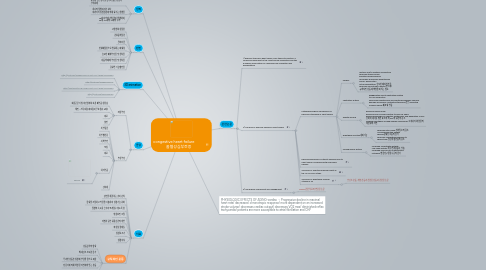
1. 정의
1.1. 총체적인 심근기능장애가 와서 신체의 대사 요구에 맞는 심박출 능력이 없는 심장의 무력상태
1.2. 하나의 질병이라기 보다 여러가지 심장질환에 의해 생기는 합병증
1.3. 75세 이후에 가장 많이 발병하며, 45세~64세의 10배의 수치
2. 원인
2.1. 고혈압성 심질환
2.2. 관상동맥질환
2.3. 류머티즘
2.4. 만성폐질환으로 발생하는 폐성심
2.5. 승모판 폐쇄부전증 및 협착증
2.6. 대동맥 폐쇄 부전증 및 협착증
2.7. 갑상선 기능항진증
3. 관련논문
3.1. 1) Exercise training in heart failure: from theory to practice. A consensus document of the Heart Failure Association and the European Association for Cardiovascular Prevention and Rehabilitation
3.2. 2) The Role of Exercise Training in Heart Failure
3.2.1. Pathophysiological Mechanisms of Exercise Intolerance in Heart Failure
3.2.1.1. Cardiac
3.2.1.1.1. Systolic and/or diastolic dysfunction Reduced stroke volume Elevated filling pressures Secondary pulmonary hypertension and RV dysfunction Mitral regurgitation 승모판 폐쇠부전증 Reduced chronotropic reserve 변시성 :규칙적인 운동에 영향을 미치는 정도
3.2.1.2. Ventilatory system
3.2.1.2.1. Exaggerated minute ventilation relative to CO2 production Pulmonary hypertension and resulting pulmonary vascular damage and fibrosis Ventilation/perfusion관류 mismatch Alveolar edema 폐포성 부종
3.2.1.3. Skeletal muscle
3.2.1.3.1. Reduced muscle mass Reduced Type IIa fibers relative to Type IIb fibers Reduced enzymes for oxidative metabolism and generation of ATP 산화적 대사를 위한 효소의 와 ATP의 생산의 감소 Delayed resynthesis of high-energy compounds 고 에너지 화합물의 재합성의 지연
3.2.1.4. Endothelial function내피기능
3.2.1.4.1. Reduced nitric oxide 산화질소의 감소 Increased reactive oxygen species활성산소종의 증가 Reduced vasodilatory response to shear stress 혈관확장반응의 감소
3.2.1.5. Neurohumoral system
3.2.1.5.1. Increased sympathetic activity Low vagal activity 미주신경활동이 낮음 Increased levels of pro-inflammatory cytokines 염증전구물질수준의 증가
3.2.2. Exercise Responses In Patients Dyspnea Due to Heart Failure Compared With Pulmonary Disease
3.2.3. Summary of Selected Adverse Events in the HF-ACTION Study
3.2.4. Summary of Resistance Training Studies in HF
3.2.4.1. 유산소 운동, 저항 운동과 혼합된 운동과 관련된 논문
3.3. 3) Leg Edema Assessment and management
3.3.1. edema관련 치료와 연관된 논문
4. 3D animation
4.1. http://youtu.be/3YddwXPWVSc?list=PL211E9661236783D0
4.2. http://youtu.be/3YddwXPWVSc
4.3. http://youtu.be/RHJBVTdBJvI?list=PL211E9661236783D0
4.4. http://youtu.be/afrRNjsWn9s
5. 증상
5.1. 좌심부전
5.1.1. 호흡곤란 기침 야간발작성 호흡 폐부종 심잡음
5.1.2. 체인 - 스톡호흡(과호흡과 무호흡이 교대)
5.1.3. 피로
5.1.4. 불안
5.2. 우심부전
5.2.1. 복부통증
5.2.2. 복부팽만감
5.2.3. 식욕부진
5.2.4. 오심
5.2.5. 피로
5.2.6. 하지부종
5.2.6.1. edema
5.2.7. 간비대
6. 치료
6.1. 원인을 해결하는 것이 원칙
6.2. 증상을 조절하고 약물을 사용하여 심장기능 강화
6.3. 질병의 속도를 늦추어 오래살수 있도록 함
6.4. 위험요인 조절
6.5. 저염식 같은 생활습관의 개선
6.6. 좌심실 절제술
6.7. 심실보조기
6.8. 심장이식
6.9. 규칙적인 운동
6.9.1. 운동능력의 향상
6.9.2. 최대산소 소모량 증가
6.9.3. 무리한 운동은 심장에 부담을 줌으로 피함
6.9.4. 전문가에 의해 처방된 자신에게 맞는 운동
6.9.5. 과체중시 체중조절
